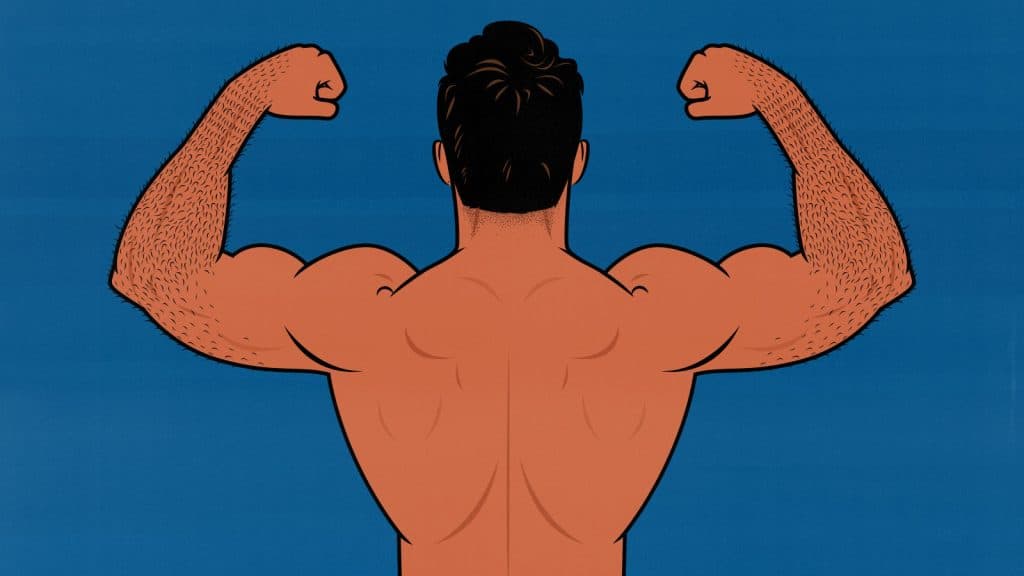
How to Build a Bigger Back: The Best Back Exercises & Workout
You can build a bigger back by doing a mix of horizontal pulls, vertical pulls, and deadlifts. Your back is made up of layers of overlapping muscles, all of which can work together, but many of which have different functions.
You could divide your back into your upper back (traps, rear delts, rhomboids, and teres major) and lower back (lats and spinal erectors), but even within the same back muscle, different regions respond better to different exercise variations. For example, your upper lats have a slightly different function from your lower lats.
You train your upper back and lats by combining vertical pulls (like chin-ups) with horizontal pulls (like rows). Adding a deadlift variation will take care of your lower back, giving you a thicker back. But it also helps to consider whether you’re tucking or flaring your elbows and whether you’re stretching and contracting your shoulder blades.
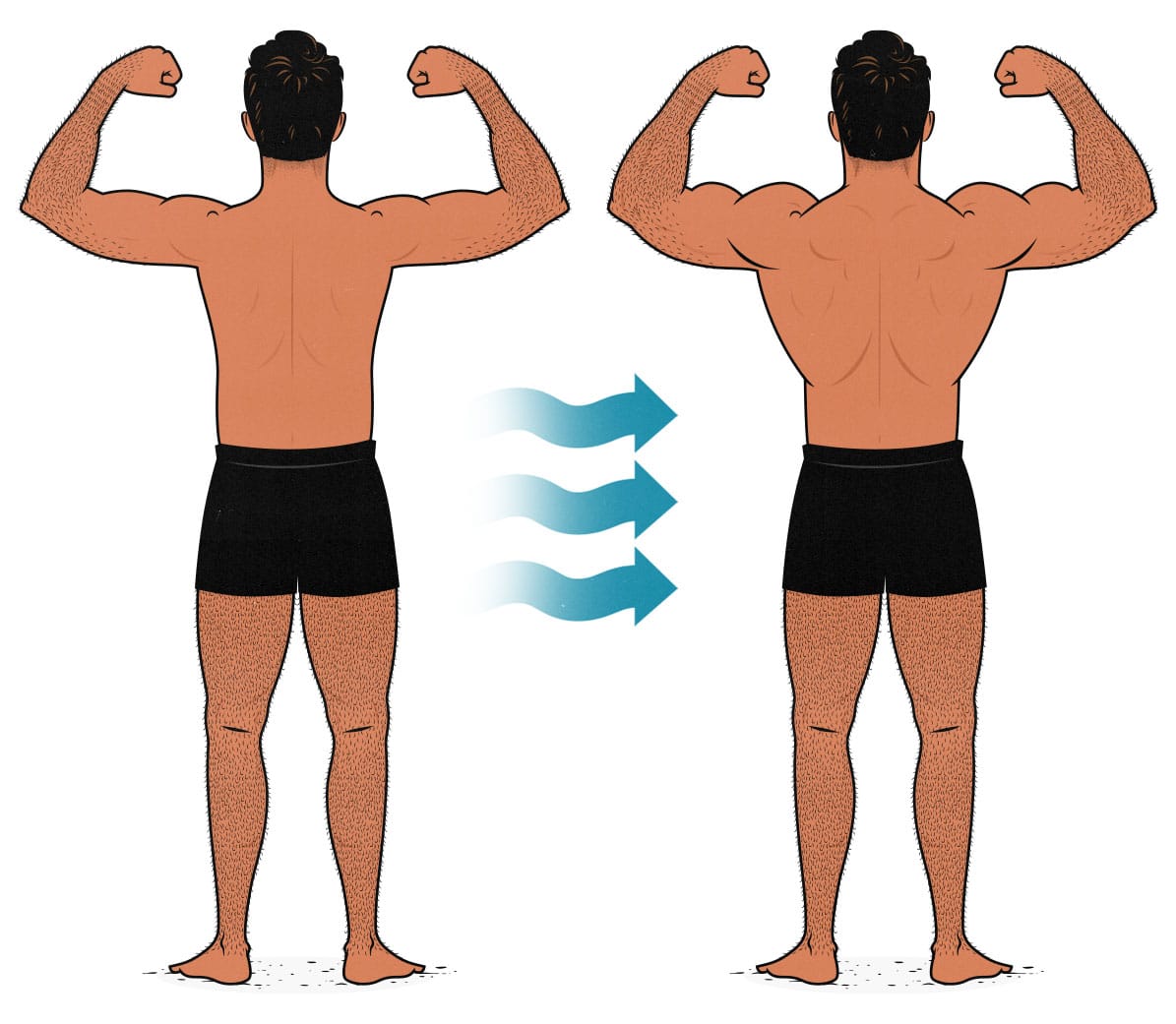
Back Muscle Anatomy for Lifters
Our backs are made up of layers of overlapping muscle groups that help us do several different things. To simplify, we can think of three groups of muscles that perform three different movements:

- The rear delts, rotator cuff, and lats help you pull things toward your body with your arms. To train them, you can think of driving your elbows back during pulling exercises. Think of exercises like chin-ups, pulldowns, and rows.
- The traps and rhomboids are primarily postural muscles. They pull your shoulders back and keep them stable. To train them through a full range of motion, reach out at the bottom of your back exercises and squeeze your shoulder blades together at the top. You can also bulk them up by carrying heavy things, which will develop their postural strength. Think of exercises like rows, deadlifts, and loaded carries.
- The spinal erectors connect the vertebrae in your spine, one again helping you stabilize your posture. To train them, you can do lifts where your postural strength is a limiting factor. Think of exercises like deadlifts, front squats, and hyperextensions.
Some exercises train all of your back muscles. Think of a barbell row. You’re pulling the weight up by driving your elbows back, your shoulder blades are stretching out and then squeezing together, and your spinal erectors are keeping your posture rigid. Rows won’t work all three muscle groups hard enough to stimulate muscle growth, though. Nor will they challenge each region of each muscle in each muscle group. That’s why it’s better to use a variety of different lifts.
Rows for Upper Back Thickness & Chin-Ups for Width?
There’s a popular saying that rows will help you build a thicker back, whereas chin-ups will help you build a wider back. As a result, most people build their back routines out of a balanced mix of rows and chin-ups. There’s a grain of truth here, but there’s a better way to think about your back training.
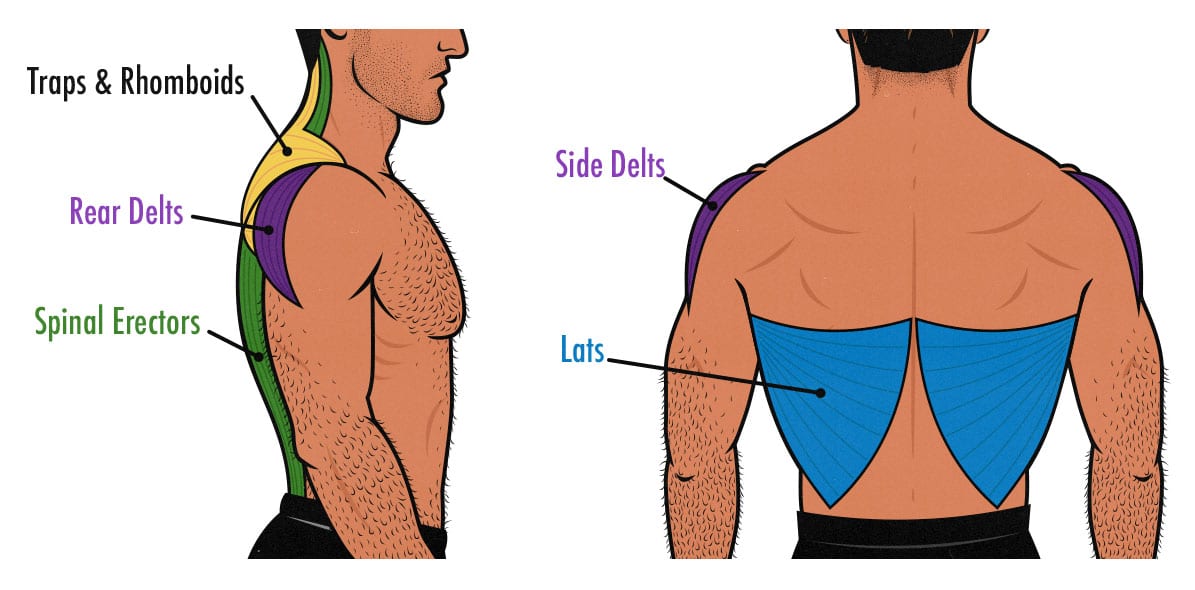
Building bigger spinal erectors can make your back thicker when viewed from the side. If you row without supporting your torso, as you’d do with a barbell row or cable row, then your spinal erectors will need to work to keep your back from rounding forward. That’s even more true of deadlifts because your spinal erectors are even more likely to be a limiting factor.
Chin-ups don’t work your spinal erectors. They won’t make your back thicker. However, they train your lats through a larger range of motion and with a better strength curve than rows, making them quite a bit better for buffing up the muscles that will make your back wider. So, yes, chin-ups can make your back wider.
There’s some truth here, for sure. But your back is more than just your lats and spinal erectors. If you aren’t paying attention, you might be doing chin-ups, rows, pulldowns, and pullovers in a way that works the exact same muscles with every exercise, failing to stimulate all the other muscles in your back.
The Best Back Exercises
There’s quite a lot of overlap between your back muscles. Rows, chin-ups, and deadlifts train almost all of your back muscles. However, they won’t necessarily challenge those muscles enough to stimulate balanced muscle growth. As a result, the best way to build a bigger, fuller back is to combine together a few different movements, each of them emphasizing different back muscles.
Then, once you’ve built a big back, it’s easy to maintain your size and strength. If you do some chin-ups and deadlifts every week, that’s more than enough to maintain all of your back muscles.
The Best Lat Exercises
Your lats are the biggest muscle in your back, especially if you lump them in with your teres major (which has a similar function and sits underneath your lats). Your lats also fan out to the sides of your torso, making them visible from the front. When it comes to building a wide back—and a big upper body overall—your lats are a good place to start.
Your lats pull your elbows towards your hips. That’s true whether you start with flared elbows or tucked elbows. Either way, your lats will pull your elbows back towards your hips, like so:

You can emphasize different regions of your lats by starting with different elbow positions. When you use a narrower grip and keep your elbows tucked, like when doing chin-ups and pullovers, you’re training shoulder extension:
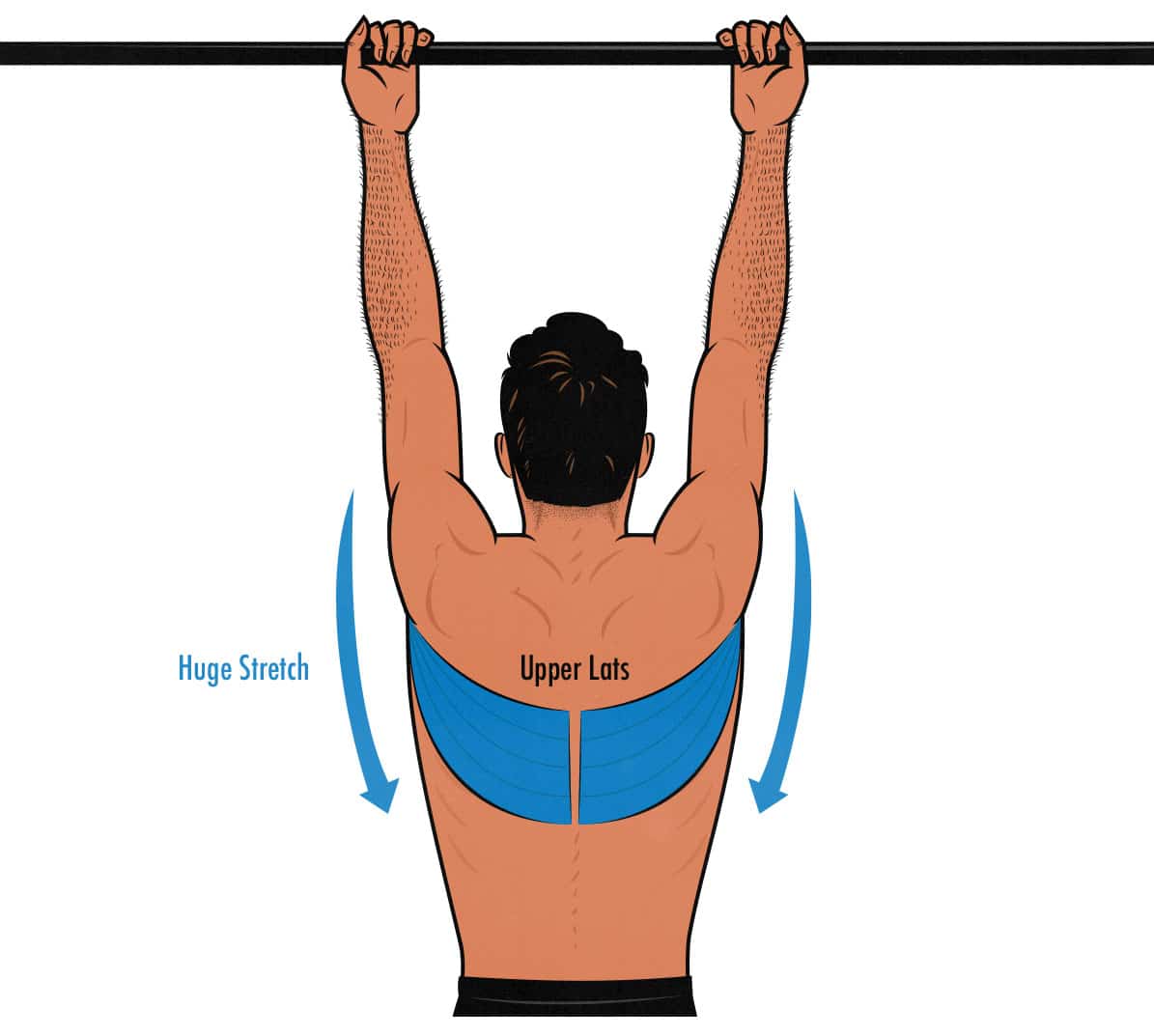
Chin-ups work all of the fibres in your lats, but your mid and upper lats are your strongest shoulder extensors, so they tend to get proportionally more of the growth stimulus. That growth stimulus is huge, too. You’re getting a tremendous stretch on your lats and working them through an enormous range of motion. A ton of other muscles contribute as well, including your upper-back muscles, abs, forearms, biceps, and triceps.
When you start with your elbows flared out to the sides, like when doing wide-grip pull-ups and pulldowns, you’re training shoulder adduction:
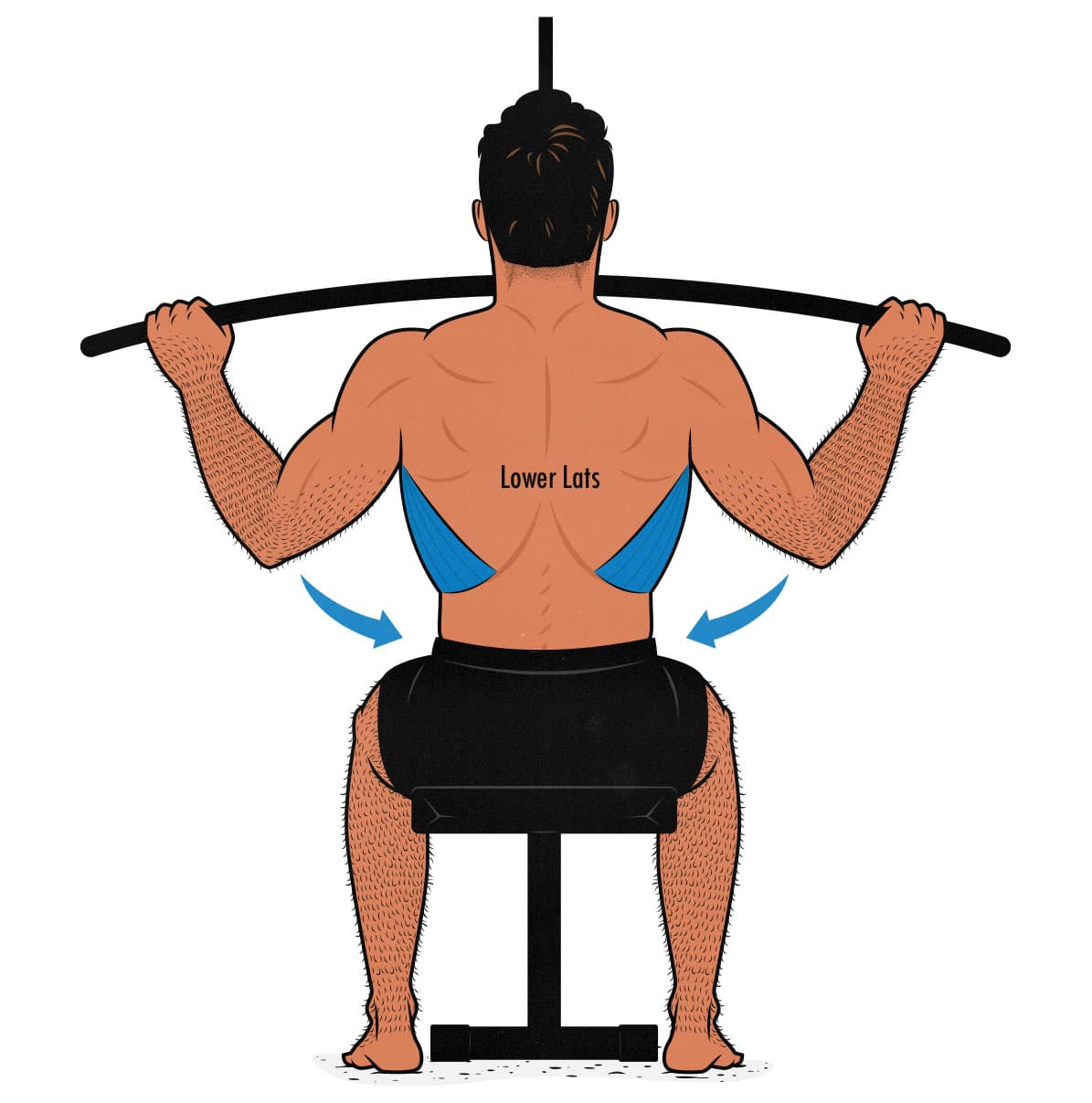
Your mid and lower lats are better adductors than your upper lats, allowing you to target them more effectively. You’ll probably notice that you’re weaker at these movements. Fewer muscles are contributing. Think of these exercises more like isolation exercises. You might want to start with a big neutral-grip chin-up and then move to a lighter wide-grip lat pulldown.
You can also train your lats with rows. Just like with chin-ups, rows pull your elbows toward your torso. The difference is that you’re starting with your arms in front of you instead of overhead, cutting the range of motion in half and reducing the growth stimulus. Rows are still good for your lats, but they’re even better for your other back muscles.
Overall, the best lat exercises are:
- Chin-ups, especially for your mid and upper lats. You’d do them with a shoulder-width grip. You can use an underhand grip (palms facing toward you), a neutral grip (palms facing each other), or anything in between. You can use a straight bar, an angled bar, or gymnastic rings. Go all the way down at the bottom, feeling a deep stretch on your lats, then think of driving your elbows toward your hips. When your elbows are in line with your torso, your lats are fully contracted. If you pull your elbows back even further, that responsibility falls to your rear delts.
- Narrower pulldowns, especially for your mid and upper lats. You’d do them just like your chin-ups, keeping your grip about shoulder width and using an underhand grip, an angled grip, or a neutral grip. You can also do these one arm at a time. However you do it, go all the way up at the top, feeling a deep stretch on your lats, then focus on driving your elbows toward your hips.
- Pullovers train your lats in a very similar way to chin-ups. The advantage is that pullovers are hardest at the very bottom of the range of motion, where your lats are under the deepest stretch. This makes them a great lat isolation exercise. You can use a dumbbell, a barbell, or an angled curl-bar. You’ll notice that pullovers are similar to skullcrushers. Your triceps can contribute to the lift. If you notice them taking over, try adjusting your grip or the degree of bend in your elbows.
- Straight-arm “lat prayer” pulldowns are very similar to pullovers. Like with pullovers, the idea is to work your lats harder when they’re under a deeper stretch. Focus on driving your elbows toward your torso.
- Wide-grip pull-ups, especially for your mid and lower lats. You can do these with your grip about 1.5 times the width of your shoulders. You can use an overhand grip (palms facing away), a neutral grip, or something in between. You can use a straight bar, an angled bar, or gymnastic rings. Go all the way down at the bottom to feel a deep stretch on your lats, then drive your elbows toward your hips.
- Wide-grip pulldowns, especially for your mid and lower lats. You’d do them just like your pull-ups, keeping your grip about 1.5 times shoulder width and using an overhand grip, an angled grip, or a neutral grip. Go all the way up at the top, feeling a deep stretch on your lats, then drive your elbows toward your hips.
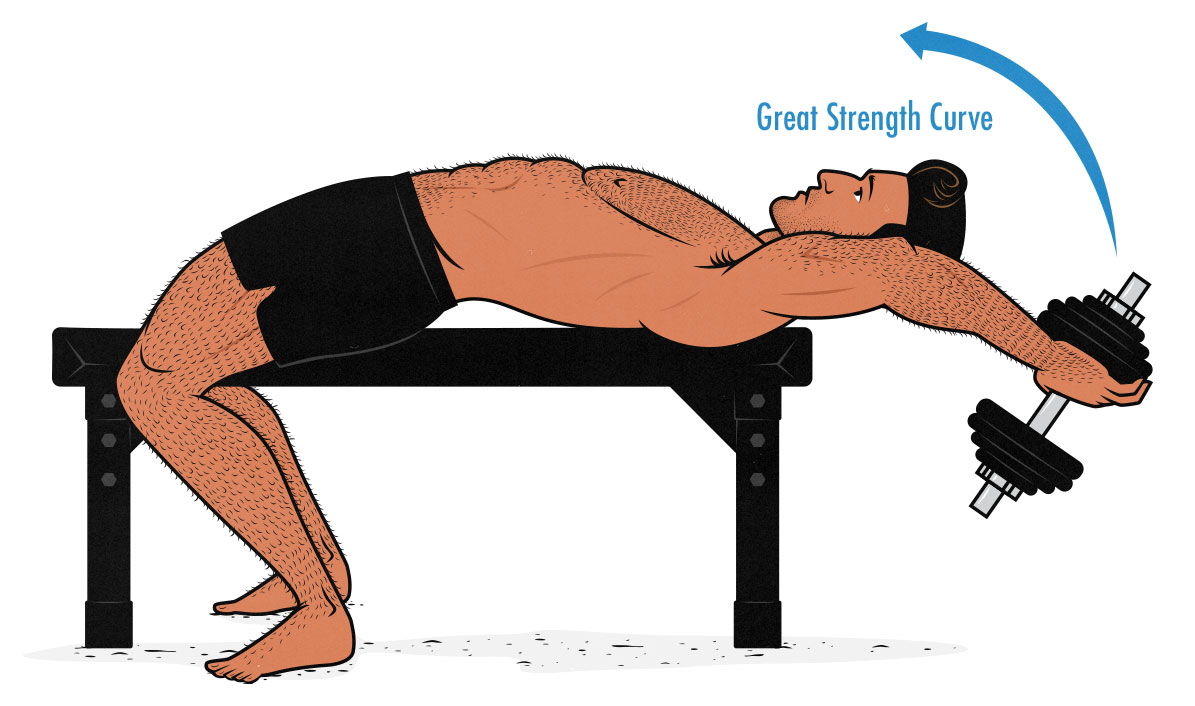
*Your rear delts have a similar function to your lats. When you train your lats, you’ll probably do a good job of training your rear delts, too. There’s this myth that our rear delts are often underdeveloped compared to our front and side delts. If you do a good job of training your back, it’s unlikely they’ll fall behind. They probably won’t need any isolation exercises.
The Best Trap and Rhomboid Exercises
Your traps are another huge back muscle. They’re only slightly smaller than your lats. They climb up your neck and spread across your upper back, making your back thicker and giving you a more formidable appearance. One of the best ways to know if a man can pick up heavy things is to look at the size of the trap muscles on either side of his neck.
Your traps and rhomboids are mainly postural muscles. They keep your shoulders strong and stable when you’re carrying heavy loads. They also keep your arms in their sockets when you’re deadlifting heavy weights. When you bend over to pick up the barbell, you’re working your mid and lower traps. As you stand up, more load shifts to your upper traps. This makes deadlifts one of the very best exercises for building huge traps.
You can also actively stretch and contract your traps and rhomboids by stretching out and then contracting your shoulder blades:
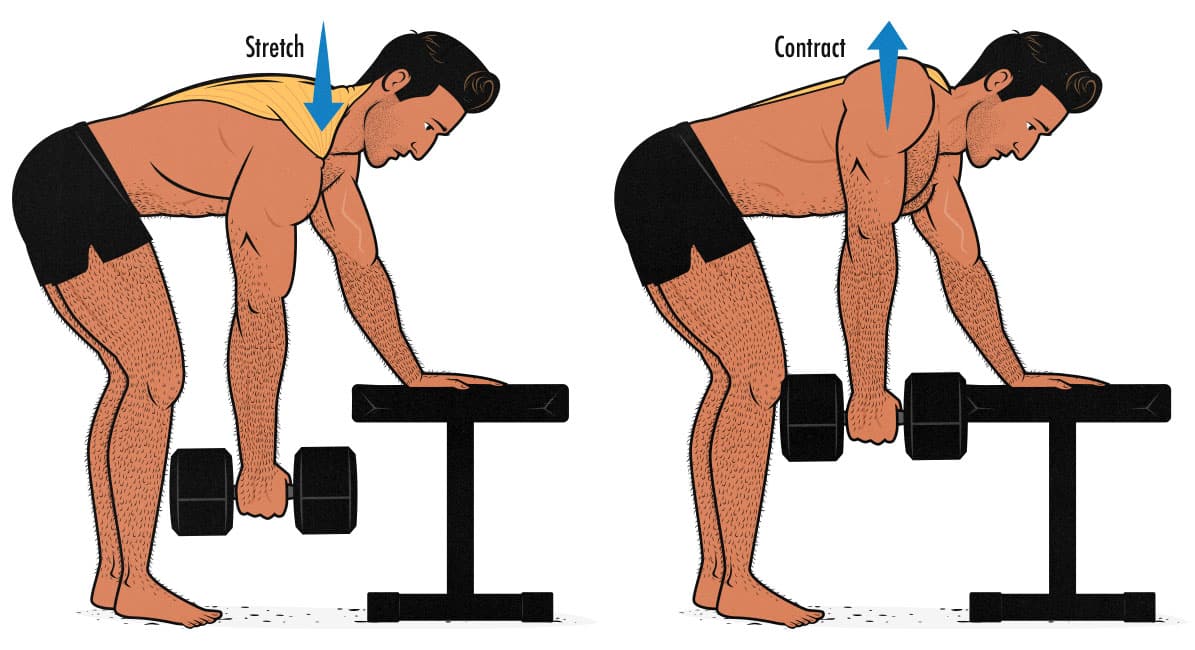
Rowing exercises are fantastic for this. You can reach out at the bottom, stretching out your traps and rhomboids, and then squeeze your shoulder blades together at the top, contracting them.

The other benefit to rows is that you’re driving your elbows back towards your torso, training your lats and rear delts. The difference is that rows tend to work your upper-back muscles a bit harder, whereas chin-ups work your lats through a deeper range of motion. A good back routine will include a mix of both.
Overall, the best trap and rhomboid exercises are:
- Deadlift variations such as conventional deadlifts, Romanian deadlifts, sumo deadlifts, and trap-bar deadlifts. The main function of the traps is postural, and deadlifts train their postural strength. Most deadlift variations train your lower, mid, and upper traps.
- Rows such as dumbbell rows, cable rows, barbell rows, inverted rows, and t-bar rows. Rows allow you to get a deep stretch on your traps and rhomboids at the bottom of the range of motion. Remember to reach out at the bottom of the lift, feeling a deep stretch between your shoulder blades.
*Many people use shrugs to isolate their upper traps, but you probably don’t need to, especially if your routine already includes deadlifts, chin-ups, rows, and loaded carries. All of the functions of your upper traps are already being trained.
The Best Spinal Erector Exercises
Your spinal erectors stretch when you round your back and contract when you flex your back. Their main function, though, is postural. They keep your spine stable, which is especially important when lifting very heavy things. These are the muscles that keep your back from rounding when you’re doing deadlifts, front squats, and barbell rows. Your spinal erectors work quite hard during other variations of those lifts, too, such as good mornings, goblet squats, and cable rows.
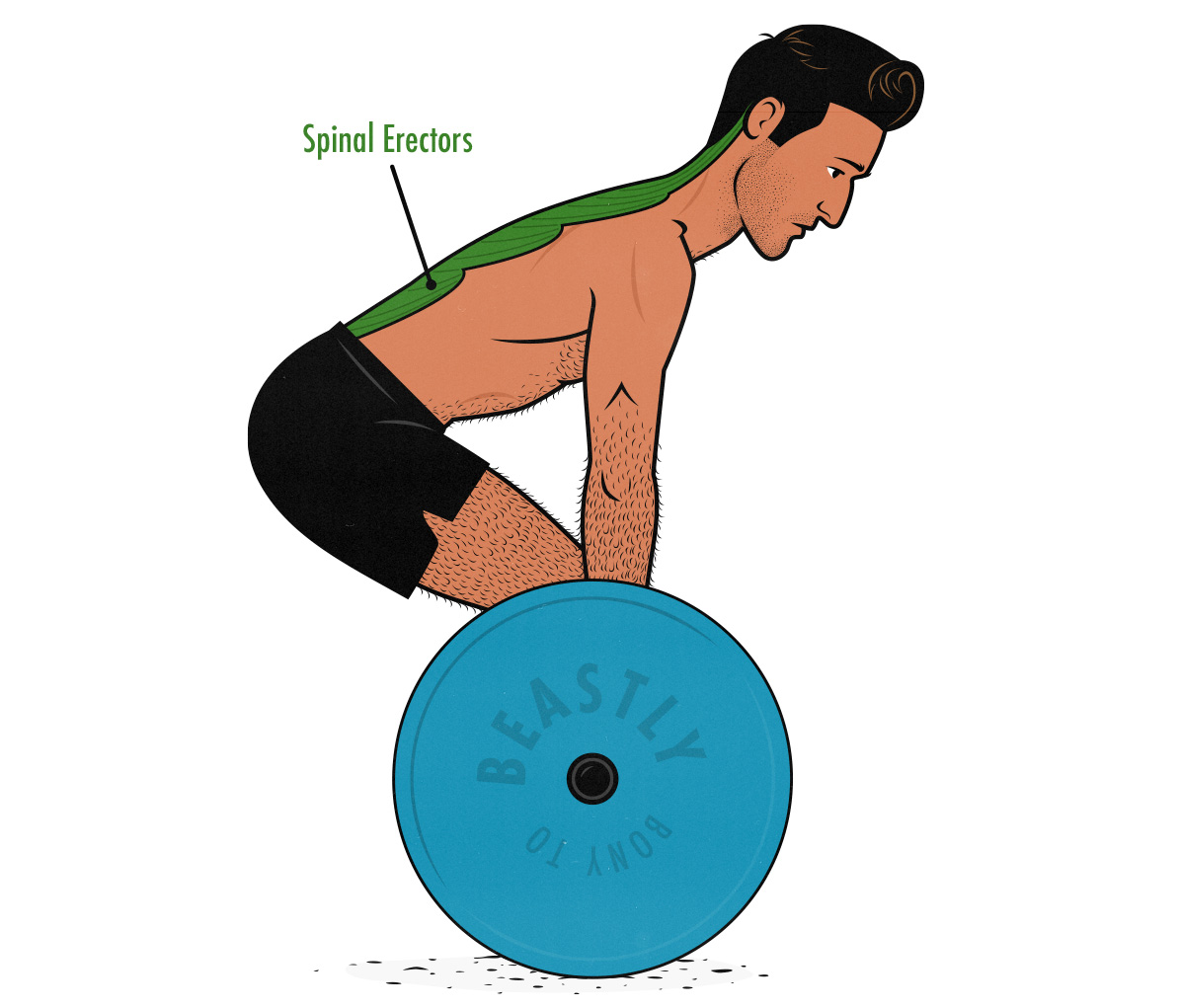
The best exercises for bulking up your spinal erectors are:
- Deadlift variations are especially good for bulking up the spinal erectors in your lower back. Conventional deadlifts put more load on your spinal erectors than Romanian and sumo deadlifts.
- Good mornings and hyperextensions are very similar to deadlifts. They’re particularly good at bulking up the spinal erectors in your lower back.
- Rows from a hinge position. Many rows are done with the torso supported, removing the strain on your spinal erectors. That allows you to focus more on your upper-back muscles. But if you’re trying to train your spinal erectors, you can choose variations without torso support, such as barbell rows, two-point dumbbell rows, and t-bar rows. Like deadlift variations, these are great for bulking up your lower back.
- Front squat variations are particularly good at bulking up your upper spinal erectors. Think of exercises like goblet squats, double-dumbbell front squats, barbell front squats, and zombie squats.
*It’s also possible to train your spinal erectors through a full range of motion by rounding your back and then arching it, as you’d see in a Jefferson curl. You probably don’t need to do that. The main function of your spinal erectors is to maintain your posture. You can fully develop them by training that primary function.
The Best Rear Delt Exercises
Your rotator cuff muscles help you externally rotate your shoulders. They can also help you pull your elbows back, especially when flared. You can train them by doing rows with flared elbows, by doing rear delt flyes, or by doing external rotation exercises like face-pulls. Your rear delts will help with these movements, too.
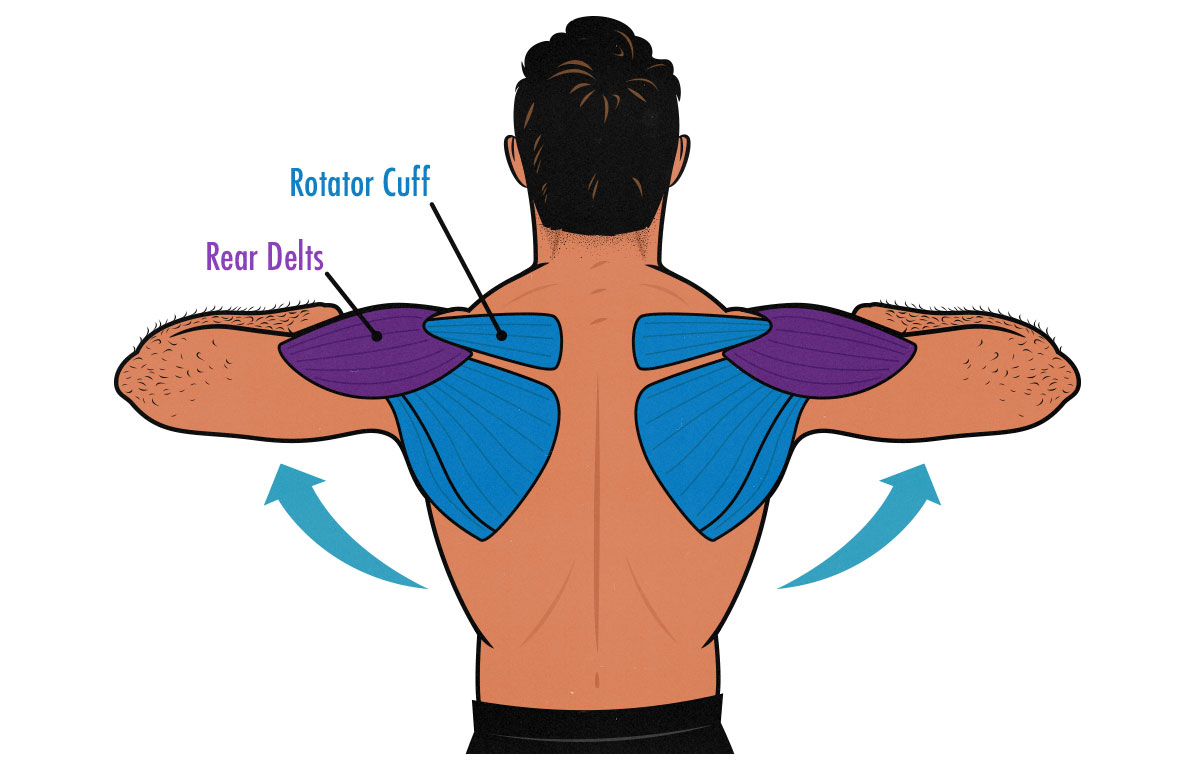
You can also train your rotator cuff with overhead pressing movements. After all, when you press a weight overhead, you’re externally rotating your shoulders under a heavy load. If your rotator cuffs are already strong, and if you’re following a balanced program that includes some overhead pressing, you may not need any extra rotator cuff work.
Training Your Back Muscles at Long Muscle Lengths
There’s a growing body of evidence showing that challenging your muscles at longer muscle lengths is far better for stimulating muscle growth, especially in the distal portions of your muscles (full explanation). The distal portions of your muscles are those further away from the midpoint of your body. So if you want lats that flare wider or traps that climb higher, you’ll want to challenge those muscles when they’re under a deep stretch.

Most back exercises succeed at stretching your back muscles but fail to challenge them in that lengthened position. Chin-ups stretch your lats and rear delts, and rows stretch your rhomboids and mid-and-lower traps, but the bottom portions of the lifts are quite easy. The harder part of a chin-up or lat pulldown is when you bring your chin (or chest) to the bar. The hardest part of a barbell or cable row is when you touch the bar to your torso.
Deadlifts are the exception, kind of. They train your traps (and glutes) under a fairly deep stretch, which is fantastic for stimulating muscle growth. They also challenge your spinal erectors in a neutral position, which isn’t ideal for stimulating growth, but it stimulates them quite well while keeping the exercise safe and strengthening your posture.
There are a couple of good ways to make your back training more effective:
- Do more sets. If each set is stimulating less muscle growth, you’ll need to do more of them to get the same overall stimulus. The problem is that you’ll be getting proportionally more stimulus in the proximal portions of your back muscles, not the distal portions. It’s not a complete solution.
- Lift more explosively. If the beginning of the range of motion is easier, that’s a great opportunity to focus on smoothly but powerfully accelerating the weight. Try to explode the weight up. That way, you can fully engage your back muscles right from the beginning of the range of motion, and you can use the momentum you generate to make the top of the lift a little bit easier. (Remember that the idea is to explode the weight up with your back muscles, not with your hips.)
- Choose variations with better resistance curves. Some exercises, such as pullovers and lat prayers, succeed at challenging your lats and rear delts under a deep stretch. That makes them valuable isolation exercises. The only problem is that these smaller movements aren’t as athletic as the classic back exercises, such as chin-ups and rows. You won’t be lifting as much weight or working as many muscles at once. I’d recommend starting most workouts with a bigger exercise before moving to the smaller “optimised” ones.
- Pause at the bottom, not the top. It’s common to pause back exercises at the top of the range of motion, where your muscles are fully contracted. That makes the exercises even harder at the hardest point, making the resistance curve even worse. It’s usually better to pause at the bottom instead, feeling a deep stretch on your muscles.
- Train to failure. When you’re doing back exercises, you’re probably failing at the very top of the range of motion. You’re failing your sets of chin-ups when you can’t quite bring your chest or your chin to the bar. You’re failing your sets of rows when you can’t quite touch the weight to your torso. There’s no breakdown in posture. It isn’t dangerous. It isn’t overly fatiguing. There’s no real harm in taking your back exercises to complete muscular failure.
- Use lengthened partials. A lengthened partial is when you keep lifting past failure, letting the range of motion get gradually smaller. When doing chin-ups, you’d start by bringing your chest to the bar. When you fail to bring your chest to the bar, keep trying to bring your chin above the bar. When you fail to bring your chin above the bar, do another rep or two, working just the bottom portion of the range of motion.
- Use exercise machines. Some back machines do a great job of challenging your back muscles through the entire range of motion. My favourite example of that is the t-bar row machine. The weight is heaviest at the beginning when you have the most leverage. Then, as you lift it, the weight gets lighter as your leverage gets worse. That evens out the strength curve, giving your back muscles more of a challenge when they’re at longer muscle lengths.

You don’t need to use all of these techniques at once. Personally, I try to lift relatively explosively during all of my exercises. I also bring all of my sets of chin-ups and rows to failure. On my final sets for each back exercise, I often keep going even as my range of motion begins to shrink.
How Many Sets Should You Do for Your Back?
There’s an adage that you ought to train your back twice for every time you train your chest. The idea is to make your back stronger than your chest, helping to pull your shoulders back and giving you a nicer posture. Mind you, many athletes train their pressing muscles with much greater veracity than their back muscles. Many recreational bodybuilders do the same. They tend to do just fine.
There is wisdom in the saying, though. You have a wider variety of pulling muscles than pressing muscles, so it can take a wider variety of exercises to train them all. Plus, back muscles tend to be quite good at handling higher training volumes.
I suspect our back muscles fatigue less easily because it’s harder to challenge them at long muscle lengths. Our chests are the opposite. Bench presses, push-ups, and dumbbell flyes challenge our chests under a deep stretch, making each set far more efficient.
Here’s what I recommend: start with a moderate training volume and work your way up as needed. Train your back 2–4 times per week and do 6–12 sets per workout, ideally including a mix of vertical pulls, horizontal pulls, and deadlifts.
Pay attention to how your back recovers. If your workout isn’t enough to make your back at least a little bit sore the next day, consider doing more sets next time. Or look at the previous section of this article to see if there’s a way to get more oomph out of the sets you’re already doing.
Most of all, though, keep track of your progress. If you’re able to progressively overload your back exercises, adding a little bit of weight or squeezing out an extra rep, that’s a great sign that you’re doing enough work to stimulate muscle growth.
Back Workout Routine
Ideally, you’d combine a deadlift variation that’s heavy enough to strain your spinal erectors, a chin-up variation with a shoulder-width grip, a pull-up/pulldown variation with a wider grip, a row variation that has you stretching and contracting your shoulder blades, and some sort of external rotation exercise, such as a face-pull or an overhead press.
You could do all of your back exercises in a dedicated back workout, but upper/lower splits and full-body workouts are just as good. Maybe on Monday, you do some deadlifts and face-pulls, on Wednesday, you do some pulldowns and rows, and then on Friday, you do some front squats and chin-ups. That will train all the muscles in your back with several overlapping exercises.
- Monday: 3×6 Deadlifts + 2×15 face-pulls.
- Wednesday: 3×12 t-bar rows + 4×10 lat pulldowns.
- Friday: 4×8 front squats + 4 sets of chin-ups (doing as many reps as possible).
If you want a minimalist back workout, go with chin-ups and deadlifts (or barbell rows). That will train almost all of the muscles in your back quite hard. Your lower lats and rotator cuff muscles might not grow at full speed, but you’ll work all the biggest muscles and develop a ton of functional strength. Many guys build impressive backs this way, and it’s certainly enough to maintain your back size if you ever want to focus on other things.

Alright, that’s it for now. If you want more muscle-building information, we have a free muscle-building newsletter. If you want a full workout and diet program, including a 5-month customizable full-body workout routine, a diet guide, a recipe book, and online coaching, check out our Bony to Beastly Program. Or, if you want a customizable intermediate muscle-building program, check out our Outlift Program.

